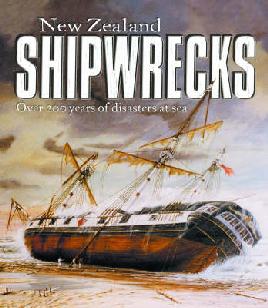 On 9 November, 1902, the steamer Elingamite struck some rocks, thought to be the middle island of the Three Kings group, situated about 50 kilometres north-west of the topmost tip of New Zealand. The ship sank and 45 people died, some immediately, some later while floating in lifeboats and rafts.
On 9 November, 1902, the steamer Elingamite struck some rocks, thought to be the middle island of the Three Kings group, situated about 50 kilometres north-west of the topmost tip of New Zealand. The ship sank and 45 people died, some immediately, some later while floating in lifeboats and rafts.
What happened?
The steamer Elingamite had left Sydney on 5 November, 1902, bound for Auckland. On board were 136 passengers and 58 crew. There was also a cargo of gold bullion worth £17,320.
At 9:00am on 9 November, the Elingamite ran into a dense fog. The steamer at once slowed to half speed and a strict lookout was kept. Almost at once however the steamer struck some rocks, thought to be the middle island of the Three Kings group, situated about 50 kilometres north-west of the topmost tip of New Zealand. Within 20 minutes the Elingamite had sunk.
Lifeboats and rafts launched
The six lifeboats and two rafts on board were launched as soon as it was realised the ship was on rocks. The master of the ship remained on board for some time, but was washed overboard. He was picked up out of the sea by one of the lifeboats, along with other passengers who were in the water.
One of the lifeboats carrying 45 people was holed when it ran into part of the wreckage from the ship. The hole was stuffed with the shirts of some of the men, and the lifeboat was kept afloat by bailing out the water. The lifeboat then tried to land on the Three Kings but was smashed on a reef. All the occupants managed to make it to the shore.
Another lifeboat floated clear as the Elingamite sank, and was able to rescue a number of survivors who were in the water. A third lifeboat landed on the Three Kings, on a beach at the bottom of some cliffs. Attempts to climb the cliffs and light a signal fire failed.
16 people ended up on the larger of the two rafts. This raft met up with the smaller raft, but the two soon lost contact with each other. The smaller raft managed to beach on the Great King Island along with another of the lifeboats. Once on land the survivors built some brush shelters and lit a signal fire.
By 12:30pm on 10 November, the second lifeboat had reached Hohoura on the east coast. The First Officer had guided the boat with 52 survivors on board over a distance of 150 kilometres without a compass and in thick fog. On board was also the body of a woman who had died from exposure.
Intensive search begins
A telegraph reporting the disaster was sent to Auckland, and several ships were sent to the Three Kings. By 11 November a further 63 passengers and 26 crew had been rescued from the island group. Still missing were the 16 occupants of the large raft, another lifeboat, and 37 people, some of whom were known to have drowned when the Elingamite sank. An intensive search began.
Three days later eight survivors were rescued from the missing raft. They had been on the raft for nearly five days, drifting further and further from the land under the combined influence of the wind and the tide. One by one eight of them had died, some driven by their hopeless state to jump into the sea. They were finally found about 100 kilometres north-east of the Three Kings. The raft was about 4 metres by 2 metres, with no shelter from rain, wind or sun. The only food was 2 apples which were each cut into 16 pieces, one on 11 November, and one on the following day.
The missing lifeboat was never found.
How many died?
45 people died (28 passengers and 17 crew).
Other events and outcomes
A court of inquiry found that the captain was guilty of negligence in his navigation, and that he made an error of judgement after the wreck in letting one of the lifeboats leave with only half the number it could carry on board. The master’s certificate was suspended for one year, and he was ordered to pay costs of £50.
In 1910 an investigation found that the Three Kings Islands position had been wrongly charted. There was a re-enquiry into the wreck of the Elingamite and the captain was cleared of any blame.
More information and sources
- Search our catalogue for information about the SS Elingamite Shipwreck.
- Shipwreck: tales of survival, courage and calamity at sea, Louise Callan, Auckland, 2000.
- New Zealand shipwrecks: 195 years of disasters at sea, C. W. N. Ingram, Auckland, 1990.
- The wreck book, Steve Locker-Lampson, Auckland, 1994.
- Wreck of the Elingamite Auckland Star, 11 November 1902 via Papers Past
Disasters
- Go to our page on New Zealand disasters
- Read some true kids books about disasters
- Read some true adult books about disasters
- Read some stories about New Zealand kids in disasters
